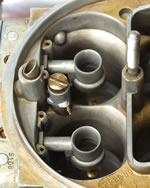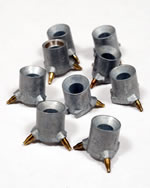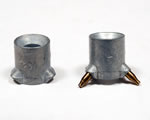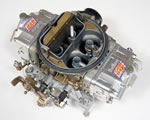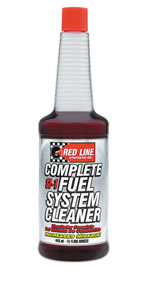Hib Halverson's Big Block From Hell Series
Hib Halverson's Big Block From Hell Series
 |
 |
by Hib Halverson
© December 2012
Holley 4150 accelerator pump function depends on the pump discharge nozzles, the pump cam and the pump capacity. Many call the nozzles "shooters" and, in a DP there are two, each with two discharge nozzles. Nozzle diameter determines the fuel flow and the length of the pump "shot". Pump capacity and the pump cam affect the volume of fuel delivered.
If the car bogs when you nail the gas, you may need larger pump nozzles. If it responds, but in a doggy manner, and/or with a puff of black smoke from the exhaust, you may have too large a nozzle size. If the car, first, goes, then sags like it's loading up, you may have too long of a pump shot and might need a pump cam change or, like me, even a smaller pump. A graph of all the pump cams is in Cartech Holley Book and there is a full-color version in the Holley catalog.
Of course, there are exceptions: first, we ended up with much less accelerator pump cam on the secondaries due, in part, to the intermediate circuit in our 850's secondary metering block.
Secondly, we had one "tip-in" response problem we could not tune out with accelerator pump work and it was a lean sag at very light load and under 1000 rpm. By raising the float level 3/16-in, we reduced that tip-in lean sag. Now, back to the accelerator pumps...
Start with the primaries. With the engine warmed and idling in the shop and keeping your face and upper body away from the top of the carb, hold the secondaries closed with your right hand and use your left to rapidly open the throttle. If the engine back fires through the primaries, jump the primary nozzle up three sizes. It hesitates a little but doesn't spit, jump the shooter up two sizes. On the other hand, if your snap the throttle open and the engine responds lazily, go down a couple of nozzle sizes. Now, do the same with the secondaries. If the engine spits as the secondaries open, jump the secondary accelerator pump nozzle up four numbers. If it just hesitates, try going up two numbers.
Once you have the pump configurations in the ball park, go road testing with your wide band O2S. You want the AFR during accelerator pump action to be between 12:1 and 13:1. Any more rich than that and the engine may respond sluggishly. Any more lean than that and the engine might have a flat spot.
If you drive the car at a slow speed and light throttle in a lower gear then quickly go to a third throttle and see the AFR spike lean, you may still need a bit larger primary pump shooter. Make changes to the primary pump and the early part of throttle opening, first. Then do transition to wide-open throttle. If the engine sags, coughs or spits when you whack the throttle wide open, go up three nozzles on the secondaries. If you punch it and the engine spikes rich and stays there, you may need to both make the nozzles smaller and use a less aggressive pump cam.
Many factors affect accelerator pump tuning—atmospheric conditions, engine size, camshaft, intake manifold, carb size, vehicle weight, gearing, tire size, duty cycle and driving style all can play into pump tuning. To end this discussion, I'll repeat my earlier observation: it's fairly easy to get the accelerator pump tuning such that there are no flat spots, but it's more difficult and time consuming to get the pump shots just right. Fortunately, with a Holley's tunability—two pump sizes, multiple pump cam profiles and many different pump nozzles—it's possible to tune the accelerator pumps to perfection. I have my 850's pumps set such that at 1500 rpm in second gear, I can floor it and the Big Block from Hell pulls hard—no bogs, no sags, no flat spots.
 |
 |

